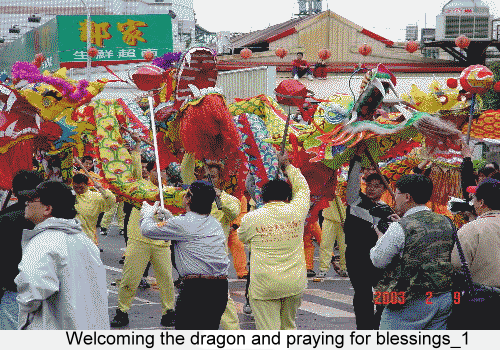| Pasting the Dragons | Dotting the Dragons’ Eyes | Welcoming the Dragons | Following the Dragons | Bombing the Dragons | Sending the Dragons Back to Heaven |
![]() Welcoming
the Dragons
Welcoming
the Dragons
“Welcoming the dragons” at the Lantern Festival has two meanings to the Hakka: one is welcoming the “dragon god” to visit them so that they may receive blessings; the other is celebrating the New Year with the dragon dance. After the eyes are dotted, the “dragon god” pays a New Year’s call door to door three days in a row, from January 15 to 17. The dragon dance teams will send “visiting cards” to households, telling them when the teams will arrive. People will then prepare paper money, firecrackers and red envelopes to greet the “dragon god.” No matter how late it is, sometimes even in the very early morning, the dragon teams must visit all the households on the schedule. Certain influential families (mostly canteens) will provide hot or baked cake and pastry for the dragon teams.
People believe that being visited by the dragons has the same effect as being visited by gods: both can eliminate ill fortune and bring good fortune. When people hear firecrackers or gongs, they pray and burn paper money to the gods and their ancestors and set off firecrackers to “welcome the dragons” to their home (according to the custom, dragon teams cannot enter houses until the dragon-welcoming procedure is completed). Hakka people’s reverence for the “dragon god” is clearly evident in this custom.
To the Hakka group in Miaoli, the dragon dance on January 15th is also a folk performance to celebrate the New Year. There is a specific procedure that dragon teams must follow, especially when visiting temples and influential families. From the dragon god descending to the mortal world, the golden dragon rising and turning, the auspicious dragon offering good fortune, worshipping the dragon god, looking for the dragon ball, the dragon catching the ball, the sleeping dragon getting up, and the dragon rolling and flying, to the coiling dragon looking back and finally leaving the house, all of the movements must be beautifully coordinated with drums and gongs. To “worship the dragon,” one must kneel on one knee to show their piety. However, not all of the movements have to be completed; different styles are performed in squares, rice courts and streets. In addition, when the dragon team passes by a temple, the “dragon lord” (the person who organizes the dragon team) must inform the temple of the dragon’s identity. After that, the dragon can pay a visit to the temple. The abbot of the temple will recognize the dragon by hanging golden flowers and a red cloth on its horns. This ritual represents that the god(s) of the temple will accompany the dragon during the visiting tour.
Every household will give dragon teams red envelopes, as a way to wish them a happy new year and acknowledge their services. The amounts of money in red envelopes depend on the dragon’s place of origin, size (number of participants), performance and the order of arrival. According to the custom, dragon teams will visit the households in their own villages on January 15th, and then visit other villages on the 16th and 17th. In the past, there were times when dragon teams competed with each other for the red envelopes of influential families in other villages, creating a scene of two dragons fighting for a “ball” and adding extra excitement to the atmosphere.
![]() Dragon-welcoming
pictures
Dragon-welcoming
pictures

![]() Data
source
Data
source
Many thanks to the Miaoli City Office for provision of photos and relevant text.
Contents also referred to the 2003-2008 Miaoli International Cultural Tourism Festival Proposal.
Data compilation: Shih-Min Lin, Wan-Ling Chen